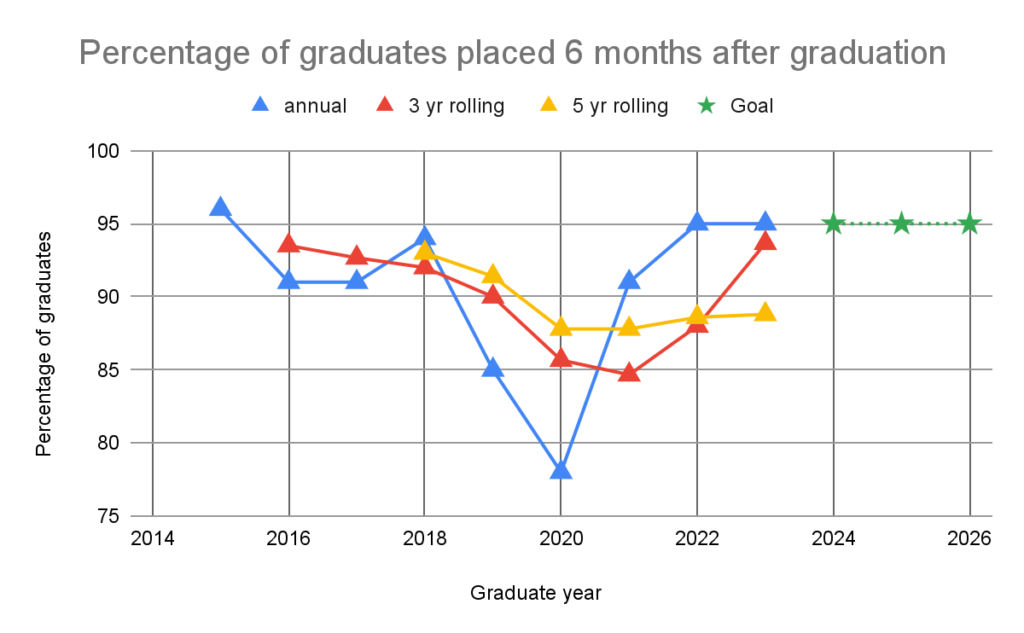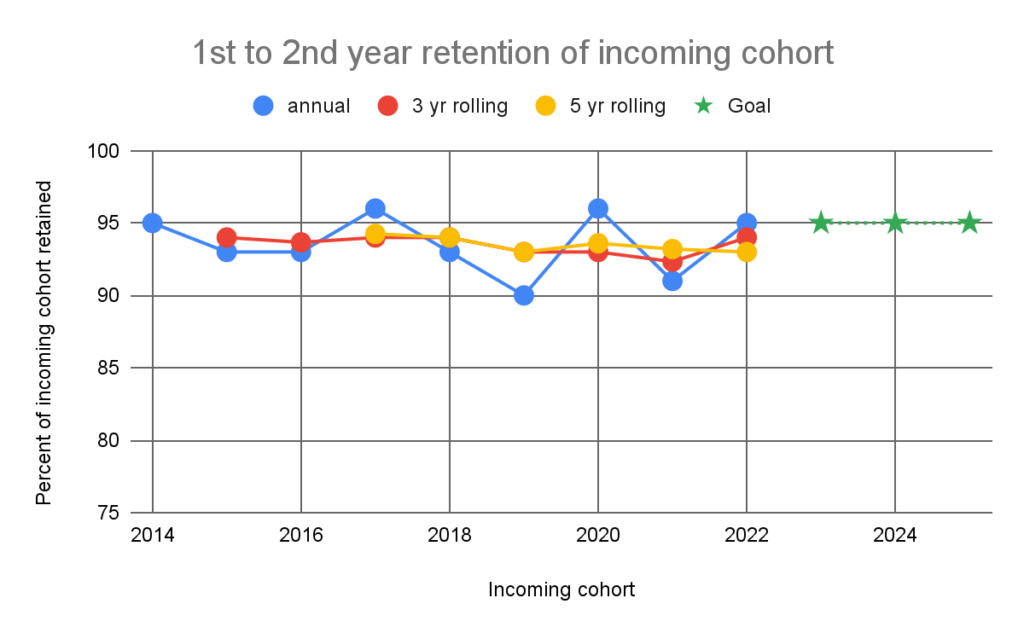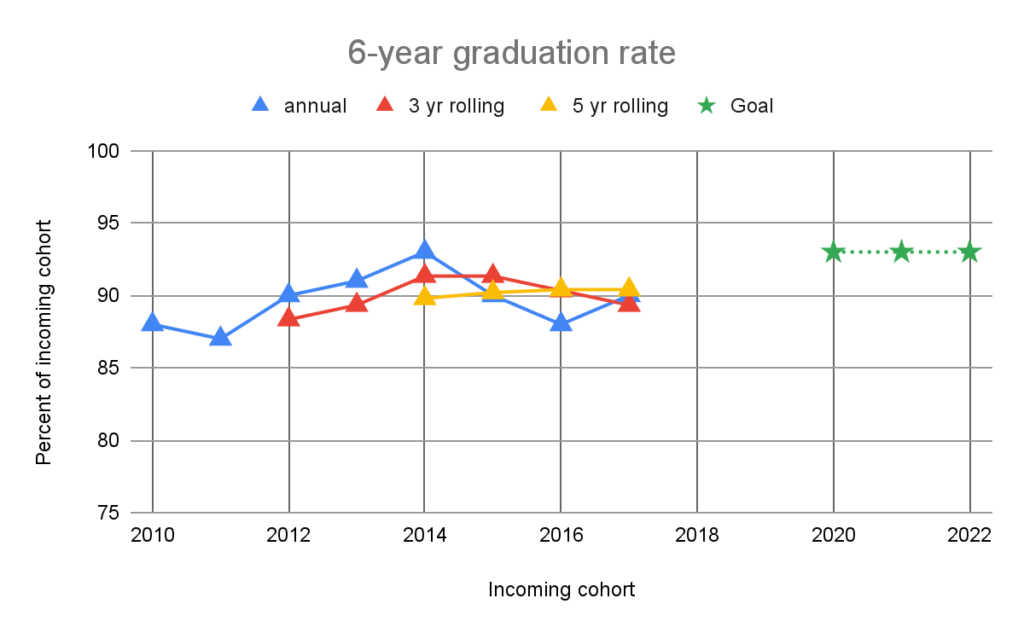Key Performance Indicators
The Key Performance Indicators (KPIs) represent institutional goals that the Senior Leadership Team (SLT) set after considering historical data as well as the headwinds facing Macalester and higher education as a whole. The selected KPI will not change because of a single intervention, new program, or shift in one area of the college. No single office or department will single-handedly move the needle. Instead, progress requires collective and coordinated effort. Every member of our community will facilitate the change we seek.
Progress toward the different KPI will occur at varying rates. Some metrics are more sensitive to year over year changes or the impacts of specific innovations, while others will advance only after multiple strategies have been implemented. As we approach 2030, the annual review of these goals will create spaces for both continued discussion about the opportunities for Macalester and reflection about areas for potential growth or change. We will continue to implement programs and iterate approaches using suggestions and feedback that impact student learning, foster community well-being, and strengthen the college for current and future generations.
This data will be updated annually in October.
Summary Table of Key Progress Indicators (KPIs) to reach by 2030
| KPI # | KPIs- goals to reach by 2030 | Current | Goal |
|---|---|---|---|
| 1 | Alumni engagement and support | 35% | 50% |
| 2 | Graduates placed six months after graduation | 95% | 95% |
| 3 | Yield on offers of admission | 23% | 26% |
| 4 | First to second year retention | 93% | 95% |
| 5 | Six year graduation rate | 90% | 93% |
Below we provide examples of current pilot programs or updates that we think will positively impact each KPI. These lists are not exhaustive, and we remain responsive to changing needs and additional suggestions.
1. Alumni engagement and support
For this metric, alumni are counted if they participate in Macalester events (e.g. Reunion, Mac in Your City, etc.), volunteer for the college (e.g. present a guest lecture, host alumni gatherings, etc.), provide financial support, or actively engage in communicating updates to the college. An alum doing more than one activity is counted only once.
Example initiatives supporting progress:
- Updating MacConnect to better facilitate interactions among alumni and between alumni and the college
- Hosting 150th anniversary celebrations, including alumni travel trips with faculty and senior administrators
- Consolidating Advancement staff offices in the renovated and accessible Lampert Building
2023-24: 35%; Goal: 50%
* NOTE: these data are only available for 2023-24 academic year. Graphs and trend data will be added as we move forward.
2. Graduates placed after six months
Macalester reports placement six months after graduation, which is consistent with standard reporting of institutions through the National Association of Colleges and Employers (NACE). Placement includes graduates who are employed, attending graduate school, interning, or on a fellowship. Our goal is to sustain a 95% placement rate for graduates that respond.
Example initiatives supporting progress:
- Making experiential learning (e.g. internships, volunteer opportunities, research experiences, and entrepreneurial programs) easier for students to navigate by consolidating the organizational structure for career exploration, entrepreneurship and innovation, and summer research opportunities
- Hiring an Associate Dean for Advising for a three-year term to lead changes in student advising structures
- Enhancing outreach to students to increase the number of students reporting their placement after graduation.

3. Yield on offers of admission
The yield rate refers to the percentage of accepted students who choose to enroll at Macalester. Our goal is to reach a yield rate of 26% by 2030. This indicator reflects the overall desirability of a Macalester education in a highly competitive and price sensitive market. Nationwide, numerous pressure points across higher education have driven yield rates downward at all but the most selective colleges and universities. Achieving this goal by 2030 depends in part on updates to campus infrastructure (e.g., campus center renovation, new residence hall and welcome center); modifications to the curriculum; innovations in advising structures; and access for all students to high-impact practices such as internships and study away.
Example initiatives supporting progress:
- Creating a 3-year ad hoc Curricular Implementation Committee to manage updates to general education and other graduation requirements
- Renovating the campus center in 2024
- Hiring an Associate Dean for Advising for a 3-year term to lead changes in student advising structures
- Changing policy so international students can use financial aid for study away starting in 2024-25
4. First to second year retention
These data are shared via the Integrated Postsecondary Education Data System (IPEDS). Our goal is to remain at or above a 95% retention rate on an annual basis. Rolling three-, four-, and five-year averages are shown.
Example initiatives supporting progress:
- Hiring an Associate Dean for Advising for a three-year term to lead changes in student advising structures
- Piloting changes to the dates and structure of the new student move-in and orientation
- Piloting a set of first-year courses as an Introduction to the Liberal Arts
- Renovating campus spaces to increase a sense of belonging for all.

5. Six-year graduation rate
The percentage of students who enrolled at Macalester in the fall of the year indicated (Incoming cohort) who graduated within 6-years is shown. While innovations that are part of the Imagine, Macalester strategic plan might influence graduation rates in the intervening period, the impacts on this metric would begin to be most clearly seen in 2030 with data from the incoming class of 2024. Our goal is to reach a 93% six-year graduation rate by 2030 (i.e. for the incoming class of 2024).
Example initiatives supporting progress:
- Hiring an Associate Dean for Advising to a 3-year term to lead changes in student advising structures
- Renovating the campus center in 2024 to provide landing space for our off-campus students
- Renovating campus spaces to increase a sense of belonging for all.
